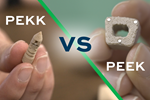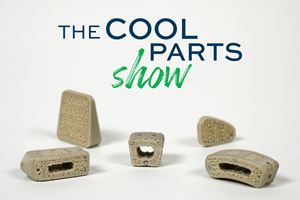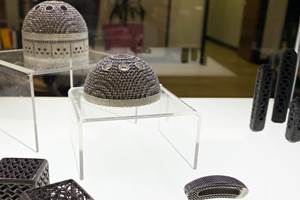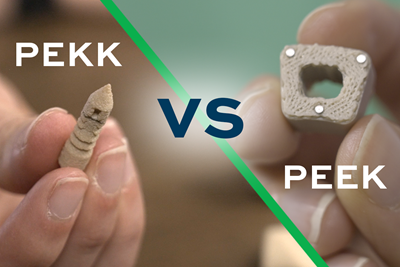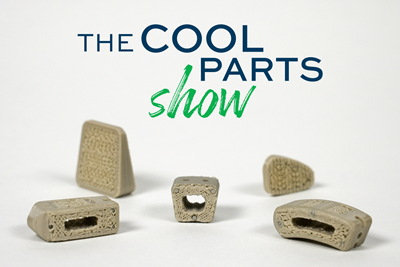Polyether ether ketone (PEEK) has been used in medical implants for more than three decades. The thermoplastic offers biocompatibility and mechanical properties similar to bone, making it suitable for spine cages, bone plates, orthopedic implants and more. As an added benefit, the material is radiolucent, meaning it does not appear in an X-ray — making it easier for the surgeon to monitor the patient’s healing post-surgery.
Curiteva’s 3D printed implants are made from PEEK, a polymer with radiolucency that enables a clear view of healing on an X-ray. Source: Curiteva
But until recently, most PEEK implants were produced through machining or molding, which placed constraints on the geometry of these medical devices. Porosity is desirable in many implants, as it can enable the patient’s own cells to grow into the device as the body heals, leading to better outcomes. Some porosity can be achieved by compression molding of PEEK, but this process does not allow for precise control of the geometry and material properties all throughout the part.
3D printing offers an alternative. Huntsville, Alabama-based medical device company Curiteva now manufactures two different product lines of 3D printed PEEK implants for the spine. Its “Inspire” line of products for cervical and lower lumbar spine features porous structures achieved through lattice-based designs, and compressive strength throughout that is developed through the printing process, Fused Strand Deposition (FSD).
Curiteva achieved FDA clearance for its first 3D printed Inspire device, the cervical spine implant in the foreground, in 2023. In 2024, the company cleared a second family of lower lumbar implants, examples of which are shown here.
A 3D Printing Process Just for PEEK
PEEK’s semicrystalline structure provides desirable mechanical and thermal properties, but also makes it more difficult to 3D print compared to molding, in which all the material is heated and solidified all at once. To 3D print PEEK, it must be heated a little at a time to temperatures above 400°C so that the material can be extruded from the printer nozzle. As the polymer cools after deposition it forms the crystalline structure that provides its strength, a process that can also result in significant warping or shrinkage.
To take advantage of PEEK’s material properties and counter their downsides, Curiteva uses a modified form of fused filament fabrication (FFF) or material extrusion 3D printing called Fused Strand Deposition. FSD is a proprietary process that was originally developed by Todd Reith under his company, Fossil Labs. Curiteva, which produces medical implants through multiple manufacturing processes, acquired Fossil Labs and its IP in 2020 in order to use FSD to produce its own products in-house. Reith joined the company as well, and serves as vice president of emergent technologies and additive manufacturing. While FSD is similar to the more common FFF technology, it has been tailored to both enable and take advantage of PEEK’s unique material properties.
Curiteva develops and manufactures the 3D printers capable of performing fused strand deposition with PEEK. Each build begins with a raft of material which elevates the implant from the platform. Source: Curiteva
“One of the most difficult things about printing PEEK is the large delta between the glass transition temperature and the melt temperature,” Reith says. “The glass transition temperature is around 140 to 150° Celsius, and the melt starts around 350 to 380°C. Because of that, the material wants to move quickly into a crystalline state. We have tailored our technology around the deposition so that we can slow down this crystallization process. We’re actually pulling strands, much like you would glass or other materials.”
The PEEK filament undergoes a drying step before it is loaded into the 3D printers to produce implants. Source: Curiteva
While standard FFF deposits filament at a consistent rate and diameter, the company’s FSD printers actually stretch the softened PEEK filament as it is extruded. This action allows for more control over the crystallization, enables better bonding between layers, and gives the polymer strands the chance to properly align themselves, Reith says. The pulled-strand approach also creates tension inside each layer that improves the printed material’s strength and durability.
“Each layer can be put in compression,” says Erik Erbe, chief scientific officer at Curiteva. “It is a toughening and strengthening mechanism. We achieve a compressive strength six times what is required for physiologic loads because of this 3D printing approach.”
3D printing enables each layer to be put in compression as it is deposited through FSD, and also makes possible novel porous structures that support osseointegration.
The FSD 3D printing process enables Curiteva to take advantage of PEEK’s unique material properties as well as apply this polymer in new geometries. The layer-by-layer method of manufacturing allows for novel porous structures that can extend throughout an implant, better enabling bone in-growth and healing.
3D Printed Implants in Production
Curiteva achieved FDA clearance for its first 3D printed PEEK product, the Inspire line of cervical spine implants, in 2023. About 30 different sizes and configurations are offered. These devices are used in patients with cervical disc generation or cervical spinal instability, and the 3D printed product was demonstrated to be equivalent to a predicate cervical interbody fusion system that the company machines from PEEK.
Achieving 510(k) clearance for the cervical spine implants took more than 18 months and close collaboration with the FDA because of the new manufacturing method. In the first year since clearance, around 50 surgeons have adopted the devices; more than 2,000 Inspire devices have been implanted in about 1,000 patients (with some having two or more implants), with no revision surgeries.
In early 2024, the company achieved clearance for a second product line of implants for the lower lumbar spine, this one consisting of more than 1,300 SKUs; because of the groundwork laid with the earlier cervical line, the new lower lumbar implants were cleared in just 57 days.
Curiteva manufactures both spine implant lines at its production facility in Huntsville, Alabama, through FSD printers housed in a cleanroom environment. Each implant is printed one at a time to maintain precise control over its thermal history on FSD machines produced by Curiteva, using PEEK filament from Evonik. After printing, support structures are removed (consisting primarily of a “raft” that holds the part slightly above the build plate) and the parts are cleaned with isopropyl alcohol and annealed for stress relief.
Minimal finish machining is performed on the printed PEEK spine implants. Only about 2% of the material is lost as scrap. Source: Curiteva
Because the PEEK material is radiolucent and invisible to an X-ray, the next step in the manufacturing process includes machining to finish surfaces and to drill holes in each implant to install titanium marker pins for visibility. (One side effect of 3D printing versus machining PEEK is that there is far less material waste and expense. Curiteva sees only 2% waste from machining of these implants, which means that almost all of the PEEK it is purchasing as filament is used in the final part.)
To support osseointegration, the hydrophobic PEEK recieves a coating of hydroxyapatite (HA, shown here close up) to make it more hydrophilic. Source: Curiteva
After another round of cleaning and laser marking, parts leave the cleanroom to depart to a supplier for a hydroxyapatite coating — a step necessary to make the naturally hydrophobic PEEK more hydrophilic, and therefore better able to support osseointegration. Finally, implants return to Curiteva for sterile packaging and are held in inventory until ordered.
Curiteva currently runs two 10-hour shifts per day, five days a week to meet its 3D printing production needs. Its nine production-qualified FSD 3D printers are enough to fulfill demand for the implants at the moment. However, the cleanroom can hold up to 20 printers, and the company anticipates scaling up in the near future.
3D printed implant production takes place almost entirely inside this cleanroom at Curiteva’s Huntsville, Alabama, facility. Parts leave to be coated in HA at a supplier, and then return for sterile packaging and storage. Nine FSD 3D printers can support the company’s implant production, but the cleanroom has space for as many as 20 of these machines.
Related Content
FDA-Approved Spine Implant Made with PEEK: The Cool Parts Show #63
Curiteva now manufactures these cervical spine implants using an unusual 3D printing method: fused strand deposition. Learn how the process works and why it’s a good pairing with PEEK in this episode of The Cool Parts Show.
Read MoreArcomedLab Utilizes Biomedical 3D Printing for 700 Successful Craniomaxilofacial Implants in Latin America
The company specializes in biomedical 3D printing with a focus on patient-centric solutions.
Read MorePrinterPrezz/Vertex Manufacturing Rebrands to Zeda
The rebranding is said to reflect the company’s “Z to A” approach, which means it starts first with the customer in mind and ends with a product.
Read More3D Printed PEEK Spine Implants in Production: The Cool Parts Show Bonus
Curiteva is using Fused Strand Deposition to produce two different lines of FDA-cleared spine implants. We visited the company’s Huntsville, Alabama, facility to learn more.
Read MoreRead Next
Understanding PEKK and PEEK for 3D Printing: The Cool Parts Show Bonus
Both materials offer properties desirable for medical implants, among other applications. In this bonus episode, hear more from Oxford Performance Materials and Curiteva about how these companies are applying PEKK and PEEK, respectively.
Read More3D Printed PEEK Spine Implants in Production: The Cool Parts Show Bonus
Curiteva is using Fused Strand Deposition to produce two different lines of FDA-cleared spine implants. We visited the company’s Huntsville, Alabama, facility to learn more.
Read MoreFDA-Approved Spine Implant Made with PEEK: The Cool Parts Show #63
Curiteva now manufactures these cervical spine implants using an unusual 3D printing method: fused strand deposition. Learn how the process works and why it’s a good pairing with PEEK in this episode of The Cool Parts Show.
Read More

.jpg;width=70;height=70;mode=crop)
